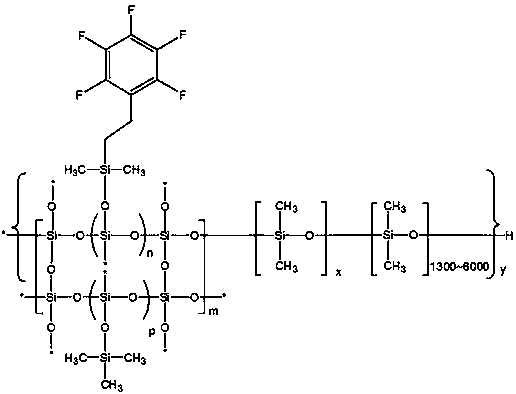High-temperature-resistant polyester composite material, and preparation method thereof
A high-temperature-resistant polyester and composite material technology, applied in the direction of fireproof coatings, coatings, etc., can solve the problems of increased crosslinking, brittleness, and debonding of adhesives, and achieves simple synthesis processes, superior heat resistance, and easy raw materials. The effect
- Summary
- Abstract
- Description
- Claims
- Application Information
AI Technical Summary
Problems solved by technology
Method used
Image
Examples
Embodiment 1
[0060] (1) Synthesis of fluorine-containing phenyl silicone resin
[0061] 5L three-neck flask, equipped with thermometer, reflux condenser and constant pressure dropping funnel, heated by oil bath. Add 800g of toluene and 650g of pentafluorostyrene in sequence, stir and dissolve, and add 2.6g of chloroplatinic acid catalyst under nitrogen protection. Turn on the heating, and after the temperature rises to 80°C, add 510 g of methyldichlorohydrogensilane dropwise, and the addition is completed in 30 minutes, and the dropping time is controlled at about 1 hour. After the dropwise addition, the insulation reaction was continued for 2 hours. After the reaction, the solvent and unreacted methyldichlorosilane were distilled off, and the 132°C fraction (3.75kPa) was collected by distillation under reduced pressure to obtain 950g of pentafluorophenethyldimethylchlorosilane. The purity of the product as measured by gas chromatography was 96.6 %, yield 90.9%.
[0062] In a 250mL Erle...
Embodiment 2
[0076] (1) The steps for synthesizing fluorine-containing phenyl silicone resin are the same as in Example 1.
[0077] (2) Polycondensation reaction
[0078] 2L three-neck flask, equipped with thermometer, water separator and reflux condenser, constant pressure addition funnel, heated by oil bath. Add 170g of 107 gum and 165g of xylene in sequence, stir and raise the temperature to 90°C, and add 1.5g of dibutyltin dilaurate (DBTL). Nitrogen was blown, and a solution of 1 g of dimethyldimethoxysilane dissolved in 20 g of xylene was added dropwise, and the addition was completed in 30 minutes, and the reaction was kept for 3 hours. Then, a solution of 325 g of fluorine-containing phenyl silicone resin dissolved in 200 g of xylene was added, the temperature was raised to 138° C., and the reaction was carried out by reflux and water separation for 24 h.
[0079] (3) Post-processing
[0080] Add 15 g of hexamethyldisilazane and 6.5 g of isopropanol to the polycondensation produc...
Embodiment 3
[0089] (1) Polycondensation reaction
[0090] 2L three-neck flask, equipped with thermometer, water separator and reflux condenser, constant pressure addition funnel, heated by oil bath. Add 169g of 107 gum and 180g of xylene in turn, stir and raise the temperature to 80°C, and add 1.5g of dibutyltin dilaurate (DBTL). Nitrogen was blown, and a solution of 1 g of dimethyldimethoxysilane dissolved in 20 g of xylene was added dropwise, and the addition was completed in 30 minutes, and the reaction was kept for 3 hours. Then, a solution of 320 g of fluorine-containing phenyl silicone resin dissolved in 200 g of xylene was added, the temperature was raised to 140° C., refluxed and water separated for 48 h.
[0091] (2) Post-processing
[0092] Add 15 g of hexamethyldisilazane and 6.5 g of isopropanol to the polycondensation product, and keep it warm for 5 hours. After the reaction is finished, the reaction is stopped, cooled and discharged to obtain a high temperature resistant ...
PUM
 Login to View More
Login to View More Abstract
Description
Claims
Application Information
 Login to View More
Login to View More - R&D
- Intellectual Property
- Life Sciences
- Materials
- Tech Scout
- Unparalleled Data Quality
- Higher Quality Content
- 60% Fewer Hallucinations
Browse by: Latest US Patents, China's latest patents, Technical Efficacy Thesaurus, Application Domain, Technology Topic, Popular Technical Reports.
© 2025 PatSnap. All rights reserved.Legal|Privacy policy|Modern Slavery Act Transparency Statement|Sitemap|About US| Contact US: help@patsnap.com



